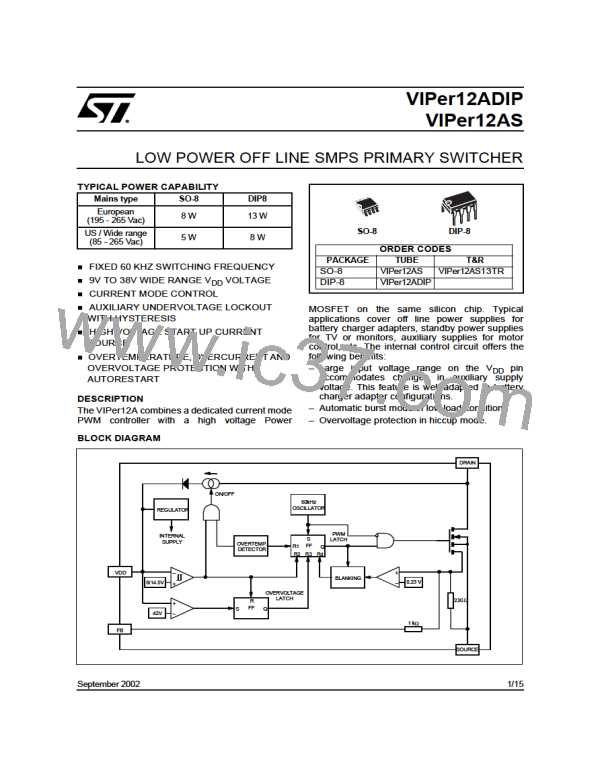VIPer12ADIP / VIPer12AS
Figure 8 : Rectangular U-I output characteristics for battery charger
DCOUT
R1
C2
T1
C1
D2
D1
D3
T2
F1
C3
AC IN
D4
ISO1
U1
C4
VDD
DRAIN
FB
C5
CONTROL
C6
SOURCE
VIPerX2A
C7
R2
D5
U2
R3
R4
C9
Vcc
Vref
R5
R6
R9
C8
R8
-
+
+
-
C10
GND
R7
TSM101
R10
GND
RECTANGULAR U-I OUTPUT
CHARACTERISTIC
WIDE RANGE OF VDD VOLTAGE
The VDD pin voltage range extends from 9V to 38V.
This feature offers a great flexibility in design to
achieve various behaviors. In figure 8 a forward
configuration has been chosen to supply the
device with two benefits:
– as soon as the device starts switching, it
immediately receives some energy from the
auxiliary winding. C5 can be therefore reduced
and a small ceramic chip (100 nF) is sufficient to
insure the filtering function. The total start up
time from the switch on of input voltage to output
voltage presence is dramatically decreased.
A complete regulation scheme can achieve
combined and accurate output characteristics.
Figure 8 presents a secondary feedback through
an optocoupler driven by a TSM101. This device
offers two operational amplifiers and a voltage
reference, thus allowing the regulation of both
output voltage and current. An integrated OR
function performs the combination of the two
resulting error signals, leading to a dual voltage
and current limitation, known as a rectangular
output characteristic.
This type of power supply is especially useful for
battery chargers where the output is mainly used in
current mode, in order to deliver a defined charging
rate. The accurate voltage regulation is also
convenient for Li-ion batteries which require both
modes of operation.
– the output current characteristic can be
maintained even with very low or zero output
voltage. Since the TSM101 is also supplied in
forward mode, it keeps the current regulation up
whatever the output voltage is.The VDD pin
voltage may vary as much as the input voltage,
that is to say with a ratio of about 4 for a wide
range application.
8/15

 STMICROELECTRONICS [ ST ]
STMICROELECTRONICS [ ST ]